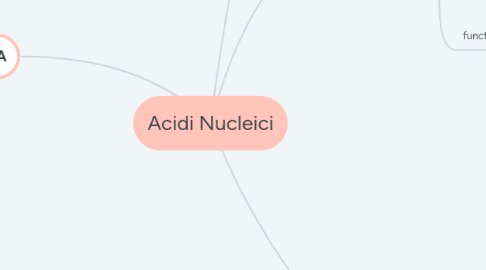
1. RNA
1.1. structure
1.1.1. nucleotide
1.1.1.1. nitrogenous base, a pentose sugar (ribose) and a phosphate group
1.1.2. the nitrogenous base thymine is replaced by uracil
1.1.3. it is a single stranded-molecule
1.2. function
1.2.1. it acts as a carrier of informations
1.2.2. mRNA
1.2.2.1. messenger RNA
1.2.2.1.1. carries the genetic information outside the nucleus toward the cytoplasm
1.2.3. tRNA
1.2.3.1. transfer RNA
1.2.3.1.1. it acts as an aminoacid carrier
1.2.4. rRNA
1.2.4.1. ribosomial RNA
1.2.4.1.1. it's a part of ribosomes
2. DNA replication
2.1. process by which DNA makes a copy of itself
2.1.1. it occurs during cell division
2.2. it is a semiconservative process
2.2.1. it keeps the old strand and uses it as a template
2.3. it must be very accurate in order to avoid mistakes; it occurs very fast
2.4. consists of 3 steps
2.4.1. start
2.4.1.1. helicase unzips the double strand
2.4.1.2. ssbp
2.4.1.2.1. these proteins keep the two strands from re-bonding each other by acting as a cap on the nucleotides
2.4.1.3. a replication fork is formed
2.4.1.4. topoisomerase
2.4.1.4.1. avoids the supercoiling of the DNA while the two strands are being separated. It is located at the beginning of the replication fork
2.4.2. elongation
2.4.2.1. primase
2.4.2.1.1. recognizes the starting point
2.4.2.2. DNA polymerase III
2.4.2.2.1. adds the nucleotides one by one
2.4.2.3. it separates the 2 strands into
2.4.2.3.1. a leading strand
2.4.2.3.2. a lagging strand
2.4.3. termination
2.4.3.1. DNA polymerase I
2.4.3.1.1. removes the primer
2.4.3.2. ligase
2.4.3.2.1. it connects all the Okazaki fragments
2.4.3.3. proofreading
2.4.3.3.1. it acts as a checker to look for mistakes
3. Discovery of DNA
3.1. Watson and Crick
3.1.1. in 1953
3.1.1.1. discovered the hydrogen bonds between the DNA strands
3.1.1.1.1. in particuar between A & T there were 2 h. bonds, whereas between G & C 3 h. bonds
3.2. Erwin Chargaff
3.2.1. discovered the equal amount of the nitrogenous bases
3.3. Rosalind Franklin
3.3.1. used the x-ray and saw the double helix structure
3.4. Watson & Crick
3.4.1. in 1962 they were awarded the Nobel prize
4. DNA
4.1. structure
4.1.1. nucleotide
4.1.1.1. made of a nitrogenous base, a pentose sugar (deoxyribose) and a phosphate group
4.1.1.2. building blocks of DNA
4.1.2. a double-stranded molecule
4.1.2.1. the two strands are antiparallel
4.1.2.1.1. the bases match each other according to the base pair complementary rule (introduced by Chargaff)
4.1.3. it has a backbone
4.1.3.1. made of the alternating of a phosphate group and a pentose sugar
4.1.3.1.1. they're linked by a phospho diester bond
4.2. function
4.2.1. it contains all the genetic information
